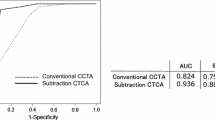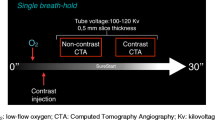Abstract
Objective
To investigate the accuracy, diagnostic confidence, and interobserver agreement of subtraction coronary CT angiography (CCTA) versus invasive coronary angiography on 320-row CT in coronary segments with severe or non-severe calcification.
Materials/methods
Sixty-four patients (33 men, 66.6 ± 8.2 years) with suspected coronary artery disease (CAD) were prospectively enrolled from October 2019 to June 2020. The cross-sectional circumferential extent of calcification was used to classify calcified segments as non-severely ( < 180°) or severely calcified ( ≥ 180°). Three independent, blinded radiologists evaluated the severity of coronary stenosis. Interobserver agreement was evaluated using Fleiss’ kappa (κ). A multiple-reader multiple-case receiver operating characteristic (ROC) method was conducted, and diagnostic accuracy was measured using the mean areas under the ROC curves (AUCs), with ≥ 50% stenosis as a cut-off. Diagnostic confidence, diagnostic accuracy, and interobserver agreement were compared between CCTA with or without subtraction information in severely and non-severely calcified segments.
Results
In cases with severe calcification (51 patients, 146 segments), CCTA with subtraction information achieved better diagnostic accuracy (per-patient AUC: 0.73 vs 0.57, p = 0.03; per-segment AUC: 0.85 vs 0.62, p = 0.01), diagnostic confidence (3.7 vs 2.6, p < 0.001), and interobserver agreement (κ: 0.59 vs 0.30). Diagnostic accuracy (per-patient AUC: 0.81 vs 0.93, p = 0.30; per-patient AUC: 0.79 vs 0.82, p = 0.54) was not increased in cases with non-severe calcification (13 patients, 190 segments).
Conclusions
CCTA with subtraction information achieved better diagnostic accuracy in cases of severe calcification (circumferential extent ≥ 180°). However, for non-severe calcification (circumferential extent < 180°), the effect of calcium subtraction was unclear, as it did not improve diagnostic accuracy.
Key Points
• Subtraction coronary CT angiography achieves better diagnostic accuracy, higher diagnostic confidence, and increased interobserver agreement for severe calcification (circumferential extent ≥ 180°).
• Calcium subtraction does not improve the diagnostic accuracy of coronary CT angiography for calcification with a circumferential extent of < 180°.






Similar content being viewed by others
Change history
16 September 2021
A Correction to this paper has been published: https://doi.org/10.1007/s00330-021-08223-y
Abbreviations
- AUC:
-
Area under the receiver operating characteristic curve
- BMI:
-
Body mass index
- CAD:
-
Coronary artery disease
- CCTA:
-
Coronary computed tomographic angiography
- FP:
-
False positive
- HR:
-
Heart rate
- ICA:
-
Invasive coronary angiography
- MRMC:
-
Multiple-reader multiple-case
References
Budoff MJ, Dowe D, Jollis JG et al (2008) Diagnostic performance of 64-multidetector row coronary computed tomographic angiography for evaluation of coronary artery stenosis in individuals without known coronary artery disease: results from the prospective multicenter ACCURACY (Assessment by Coronary Computed Tomographic Angiography of Individuals Undergoing Invasive Coronary Angiography) trial. J Am Coll Cardiol 52(21):1724–1732
Miller JM, Rochitte CE, Dewey M et al (2008) Diagnostic performance of coronary angiography by 64-row CT. N Engl J Med 359(22):2324–2336
Haase R, Schlattmann P, Gueret P et al (2019) Diagnosis of obstructive coronary artery disease using computed tomography angiography in patients with stable chest pain depending on clinical probability and in clinically important subgroups: meta-analysis of individual patient data. BMJ 365:l1945
Andrew M, John H (2015) The challenge of coronary calcium on coronary computed tomographic angiography (CCTA) scans: effect on interpretation and possible solutions. Int J Card Imaging 31(Suppl 2):145–157
Vavere AL, Arbab-Zadeh A, Rochitte CE et al (2011) Coronary artery stenoses: accuracy of 64-detector row CT angiography in segments with mild, moderate, or severe calcification--a subanalysis of the CORE-64 trial. Radiology 261(1):100–108
Ong TK, Chin SP, Liew CK et al (2006) Accuracy of 64-row multidetector computed tomography in detecting coronary artery disease in 134 symptomatic patients: influence of calcification. Am Heart J 151(6):1323 e1321–1323 e1326
Yoshioka K, Tanaka R, Muranaka K (2012) Subtraction coronary CT angiography for calcified lesions. Cardiol Clin 30(1):93–102
Tanaka R, Yoshioka K, Muranaka K et al (2013) Improved evaluation of calcified segments on coronary CT angiography: a feasibility study of coronary calcium subtraction. Int J Card Imaging 29(Suppl 2):75–81
Fuchs A, Kuhl JT, Chen MY et al (2015) Feasibility of coronary calcium and stent image subtraction using 320-detector row CT angiography. J Cardiovasc Comput Tomogr 9(5):393–398
Fuchs A, Kuhl JT, Chen MY et al (2018) Subtraction CT angiography improves evaluation of significant coronary artery disease in patients with severe calcifications or stents-the C-Sub 320 multicenter trial. Eur Radiol 28(10):4077–4085
Yamaguchi T, Ichikawa K, Takahashi D, Sugaya T, Furuya J, Igarashi K (2017) A new contrast enhancement protocol for subtraction coronary computed tomography requiring a short breath-holding time. Acad Radiol 24(1):38–44
Amanuma M, Kondo T, Sano T et al (2015) Subtraction coronary computed tomography in patients with severe calcification. Int J Card Imaging 31(8):1635–1642
Leipsic J, Abbara S, Achenbach S et al (2014) SCCT guidelines for the interpretation and reporting of coronary CT angiography: a report of the Society of Cardiovascular Computed Tomography Guidelines Committee. J Cardiovasc Comput Tomogr 8(5):342–358
Cury RC, Abbara S, Achenbach S et al (2016) CAD-RADS(TM) Coronary artery disease - reporting and data system. An expert consensus document of the Society of Cardiovascular Computed Tomography (SCCT), the American College of Radiology (ACR) and the North American Society for Cardiovascular Imaging (NASCI). Endorsed by the American College of Cardiology J Cardiovasc Comput Tomogr 10(4):269–281
Genders TS, Spronk S, Stijnen T, Steyerberg EW, Lesaffre E, Hunink MG (2012) Methods for calculating sensitivity and specificity of clustered data: a tutorial. Radiology 265(3):910–916
Gallas BDBA, Samuelson FW, Wagner RF (2009) A framework for randomeffects ROC analysis: biases with the bootstrap and other variance estimators. Commun Stat Theory Methods 38(15):2586–2603
Vilades Medel D, Leta R, Alomar Serralach X, Carreras Costa F, Pons-Llado G (2016) Reliability of a new method for coronary artery calcium or metal subtraction by 320-row cardiac CT. Eur Radiol 26(9):3208–3214
Yoshioka K, Tanaka R, Muranaka K et al (2015) Subtraction coronary CT angiography using second-generation 320-detector row CT. Int J Card Imaging 31(Suppl 1):51–58
Yoshioka K, Tanaka R, Nagata K et al (2016) Modified subtraction coronary CT angiography method for patients unable to perform long breath-holds: a preliminary study. Acad Radiol 23(9):1170–1175
Yoshioka K, Tanaka R, Takagi H et al (2016) Diagnostic accuracy of a modified subtraction coronary CT angiography method with short breath-holding time: a feasibility study. Br J Radiol 89(1066):20160489
Hong C, Pilgram TK, Zhu F, Bae KT (2004) Is coronary artery calcium mass related to Agatston score? Acad Radiol 11(3):286–292
De Santis D, Jin KN, Schoepf UJ et al (2018) Heavily calcified coronary arteries: advanced calcium subtraction improves luminal visualization and diagnostic confidence in dual-energy coronary computed tomography angiography. Invest Radiol 53(2):103–109
Funding
This study has received funding from National Key Research and Development Program of China (grant 2019YFE0107800), National Natural Science Foundation of China (grants 81671650, 81971569) and Beijing Municipal Science and technology commission (grant Z201100005620009).
Author information
Authors and Affiliations
Corresponding authors
Ethics declarations
Guarantor
The scientific guarantor of this publication is Yi He.
Conflict of interest
One of the authors of this manuscript (Yinghao Xu) is an employee of Canon Medical Systems. The remaining authors declare no relationships with any companies whose products or services may be related to the subject matter of the article.
Statistics and biometry
No complex statistical methods were necessary for this paper.
Informed consent
Written informed consent was obtained from all patients in this study.
Ethical approval
Institutional Review Board approval was obtained.
Methodology
• Retrospective
• Diagnostic or prognostic study
• Performed at one institution
Additional information
Publisher’s note
Springer Nature remains neutral with regard to jurisdictional claims in published maps and institutional affiliations.
The original online version of this article was revised: The funding information and the conflict of interest were incorrect.
Supplementary information
ESM 1
(DOCX 22 kb)
Rights and permissions
About this article
Cite this article
Xu, L., Li, F., Wu, K. et al. Subtraction improves the accuracy of coronary CT angiography for detecting obstructive disease in severely calcified segments. Eur Radiol 31, 6211–6219 (2021). https://doi.org/10.1007/s00330-021-08092-5
Received:
Revised:
Accepted:
Published:
Issue Date:
DOI: https://doi.org/10.1007/s00330-021-08092-5




